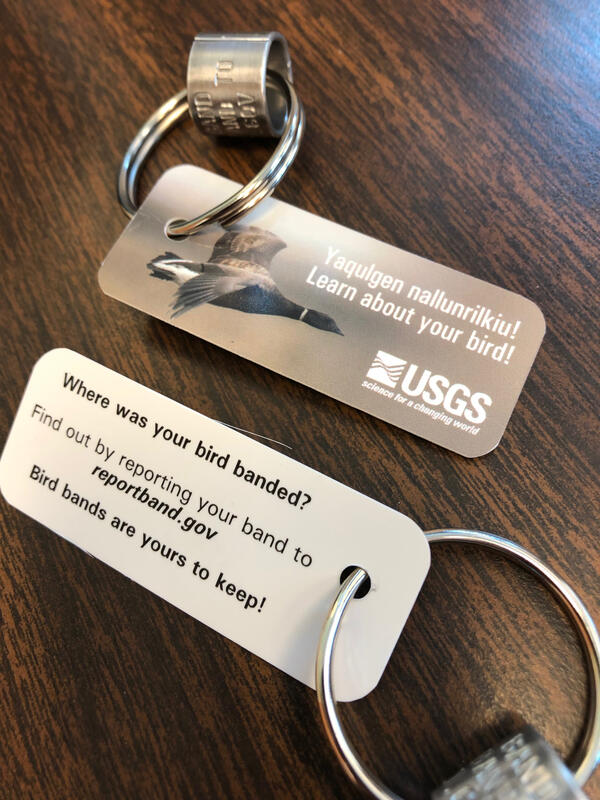Keychain developed for USGS outreach activities about bird banding and reporting in Yup'ik and English. Yup'ik translation provided by Jakob Sipary, Alaska Native Science and Engineering Program (ANSEP).
John M. Pearce, Ph.D.
I am the Program Manager for marine and terrestrial ecosystems research at the USGS Alaska Science Center. I also coordinate the USGS Changing Arctic Ecosystems Initiative and provide outreach to the public about our research. I have been a research biologist in Alaska for 25 plus years studying migratory birds, avian disease, and population genetics.
Professional Experience
2011 - Present Associate Center Director for Ecosystems, USGS Alaska Science Center
1999 - 2011 Research Wildlife Biologist, USGS Alaska Science Center
1997 - 1999 Geneticist, USGS Alaska Biological Science Center
1990 - 1997 Biological Science Technician, U.S. Fish & Wildlife Service and National Biological Service
Education and Certifications
Ph.D. 2008 University of Alaska Fairbanks, Fairbanks, AK Biology
M.S. 1996 University of Idaho, Moscow, ID Zoology
B.S. 1990 Lewis and Clark College, Portland, OR Biology
Science and Products
Q&A: The Role of USGS Ecosystems Science in Alaska
High Priority Species for Avian Influenza in Alaska
Avian Influenza Research
Swan Research
Dabbling and Diving Duck Research
Sea Duck Research

Keychain developed for USGS outreach activities about bird banding and reporting in Yup'ik and English. Yup'ik translation provided by Jakob Sipary, Alaska Native Science and Engineering Program (ANSEP).
Canada goose (Branta canadensis), Anchorage, AK
Canada goose (Branta canadensis), Anchorage, AK
A flock of wintering northern pintail ducks takes flight in Northern Honshu, Japan.
A flock of wintering northern pintail ducks takes flight in Northern Honshu, Japan.

White-fronted geese at their nest site while a caribou stands in the foreground on the Arctic Coastal Plain in northern Alaska. June 2014, USGS photo.
White-fronted geese at their nest site while a caribou stands in the foreground on the Arctic Coastal Plain in northern Alaska. June 2014, USGS photo.

White-fronted geese defend their nest from an arctic fox on the Arctic Coastal Plain in northern Alaska. June 2014, USGS photo.
White-fronted geese defend their nest from an arctic fox on the Arctic Coastal Plain in northern Alaska. June 2014, USGS photo.
Tundra swans on Alaskan breeding grounds. Tundra Swans breed on the tundra of Northern latitudes.
Tundra swans on Alaskan breeding grounds. Tundra Swans breed on the tundra of Northern latitudes.
The Role of Environment and Wildlife in Human Health. Human - wildlife interactions threatened by emerging diseases including avian influenza.
The Role of Environment and Wildlife in Human Health. Human - wildlife interactions threatened by emerging diseases including avian influenza.
A flock of wintering northern pintail ducks takes flight in Northern Honshu, Japan. This photo was taken as part of a study to understand the migratory movements of this species and to assess if these birds could transmit highly pathogenic avian influenza from Asia to North America via Alaska.
A flock of wintering northern pintail ducks takes flight in Northern Honshu, Japan. This photo was taken as part of a study to understand the migratory movements of this species and to assess if these birds could transmit highly pathogenic avian influenza from Asia to North America via Alaska.
Visualizing populations of North American sea ducks: Maps to guide research and management planning
Algal toxins in Alaskan seabirds: Evaluating the role of saxitoxin and domoic acid in a large-scale die-off of Common Murres
Summary of wildlife-related research on the coastal plain of the Arctic National Wildlife Refuge, Alaska, 2002–17
Vectors, hosts, and control measures for Zika virus in the Americas
Environment and science
Surveillance for Eurasian-origin and intercontinental reassortant highly pathogenic influenza A viruses in Alaska, spring and summer 2015
Science and Products
Q&A: The Role of USGS Ecosystems Science in Alaska
High Priority Species for Avian Influenza in Alaska
Avian Influenza Research
Swan Research
Dabbling and Diving Duck Research
Sea Duck Research

Keychain developed for USGS outreach activities about bird banding and reporting in Yup'ik and English. Yup'ik translation provided by Jakob Sipary, Alaska Native Science and Engineering Program (ANSEP).
Keychain developed for USGS outreach activities about bird banding and reporting in Yup'ik and English. Yup'ik translation provided by Jakob Sipary, Alaska Native Science and Engineering Program (ANSEP).
Canada goose (Branta canadensis), Anchorage, AK
Canada goose (Branta canadensis), Anchorage, AK
A flock of wintering northern pintail ducks takes flight in Northern Honshu, Japan.
A flock of wintering northern pintail ducks takes flight in Northern Honshu, Japan.

White-fronted geese at their nest site while a caribou stands in the foreground on the Arctic Coastal Plain in northern Alaska. June 2014, USGS photo.
White-fronted geese at their nest site while a caribou stands in the foreground on the Arctic Coastal Plain in northern Alaska. June 2014, USGS photo.

White-fronted geese defend their nest from an arctic fox on the Arctic Coastal Plain in northern Alaska. June 2014, USGS photo.
White-fronted geese defend their nest from an arctic fox on the Arctic Coastal Plain in northern Alaska. June 2014, USGS photo.
Tundra swans on Alaskan breeding grounds. Tundra Swans breed on the tundra of Northern latitudes.
Tundra swans on Alaskan breeding grounds. Tundra Swans breed on the tundra of Northern latitudes.
The Role of Environment and Wildlife in Human Health. Human - wildlife interactions threatened by emerging diseases including avian influenza.
The Role of Environment and Wildlife in Human Health. Human - wildlife interactions threatened by emerging diseases including avian influenza.
A flock of wintering northern pintail ducks takes flight in Northern Honshu, Japan. This photo was taken as part of a study to understand the migratory movements of this species and to assess if these birds could transmit highly pathogenic avian influenza from Asia to North America via Alaska.
A flock of wintering northern pintail ducks takes flight in Northern Honshu, Japan. This photo was taken as part of a study to understand the migratory movements of this species and to assess if these birds could transmit highly pathogenic avian influenza from Asia to North America via Alaska.










